#Calyptorhynchus
Text
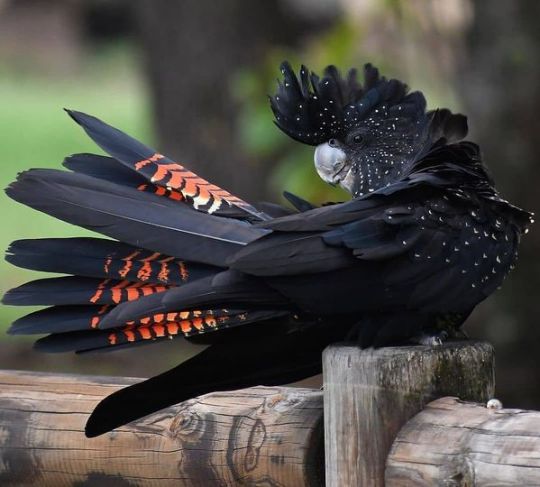
Red-tailed Black Cockatoo (Calyptorhynchus banksii), family Cacatuidae, Australia
photograph by @_thr0ugh_my_eyes
4K notes
·
View notes
Text
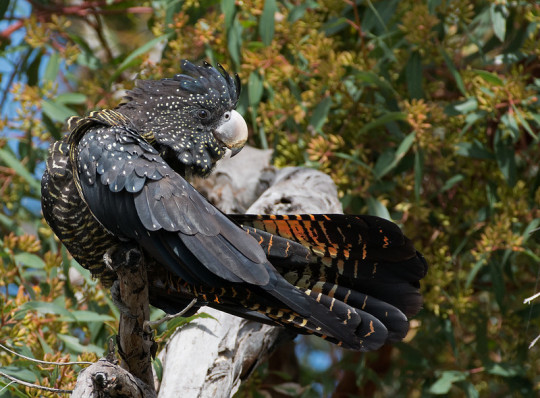
A red-tailed black cockatoo (Calyptorhynchus banksii) in Perth, Western Australia
by John Anderson
#red tailed black cockatoo#cockatoos#parrots#birds#Calyptorhynchus banksii#Calyptorhynchus#cacatuidae#psittaciformes#aves#chordata#wildlife: australia
1K notes
·
View notes
Photo
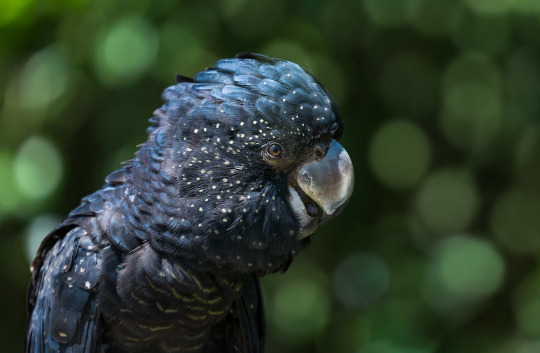
Friendliest Black Cockatoo by LUISXIX
Red-tailed Black Cockatoo (Calyptorhynchus banksii)
#red-tailed black cockatoo#black cockatoo#cockatoo#parrot#bird#Calyptorhynchus banksii#Calyptorhynchus#my new d&d character
247 notes
·
View notes
Photo

A male glossy black-cockatoo (Calyptorhynchus lathami) in flight.
Image credit: Matt Elsley/Eco Logical Australia
#matt elsley#photographer#eco logical australia#australian geographic#australia#glossy black-cockatoo#calyptorhynchus lathami#bird photography#nature
121 notes
·
View notes
Photo

vaporwave
what can i say? they really are beautiful feathers. vaporwave is very fitting
Posted using PostyBirb
#Forest#Red-tailed#Black#Cockatoo#Calyptorhynchus banksii naso#vaporwave#sunset#sunrise#purple#tail#feather#feathers#bird#parrot
6 notes
·
View notes
Text

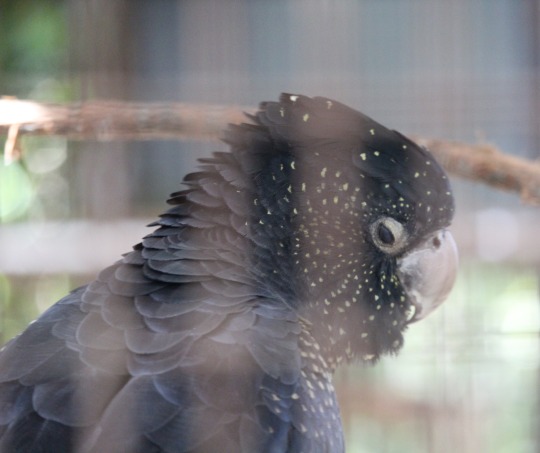

The Red Tailed Black cockatoo (Calyptorhynchus banksii)
"Ngaoara or Karrak" In the language of the Noongar People.
An amazing species of Cockatoo that have a truly beautiful colouring. While the males are solid black with a bright crimson tail, I believe the ladies take the cake on this one. These three gorgeous girls show off not only the starry sky pattern they carry but the fiery energy of their tails.
It is believed that they act as guardians to loved ones, bringing them to rest with the ancestors. Seeing a black cockatoo can also mean that rain is coming, further enforcing their identity as a symbol of change.
They are listed as Vulnerable at the moment due to habitat loss, rare nest hollows and invasive species.
#birblr#bird#parrot#birb#australian wildlife#cockatoos#black cockatoo#red tailed black cockatoo#wildlife sanctuary
159 notes
·
View notes
Note
🥚Ooh hi hi hi hello lovely one!
Would you be so gracious and kind to assign me a birdie?


red-tailed black cockatoo!
(Calyptorhynchus banksii)
60 notes
·
View notes
Text






The Glossy Black-Cockatoo/Calyptorhynchus lathami! (Source Link)
Here's an identification guide for the different types of black cockatoos in Australia (link) and here (link)
#gifset#my gifs#bird gif#glossy black cockatoo#fast gif#stim gifs#bird stim#bird stim gifs#bird stims
7 notes
·
View notes
Text
Actually while I'm still a bird blog (literally just for today) here's some other birds I'm fond of/think would be GREAT in Skyjacks:

Willie Wagtail (Rhipidura leucophrys)
Tiny, adjustable eyebrows, fan tail, fantastically acrobatic fliers. Two kinds of noises: angry shouting and beautiful singing. Diet is primarily insects but they have been known to eat carrion of far larger animals. Not afraid of humans. Made mostly of audacity: will often attack much larger birds including magpies, ravens and occasionally even osprey (sea eagles) or wedge-tailed eagles.

Currawong (Strepera sp.)
Three species of absolute clown disguised as dapper goths. Very clever and capable of bastardry: wild populations have been documented unzipping bags to get at the contents. All round omnivore. Social. Soup dragon noises.
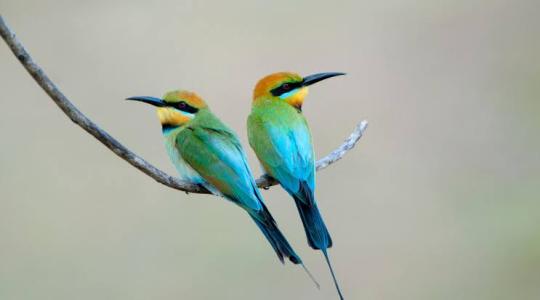
Rainbow bee-eater (Merops ornatus)
Rainbow, eats bees (and other insects, but especially bees). Migratory, can fly far distances for a little bird. Makes and then nests in underground burrows. Very social. Makes delightful prrt noises and exhibits some very cute huddling behaviour.

Red-tailed black cockatoo (Calyptorhynchus banksii)
Large, loud and social. Shy with humans but not absent from urban and suburban areas. Dangerous if you happen to be a delicious seed pod, or item that looks fun to chew on. Capable of high flying, rarely comes down to the ground (mostly hangs out in trees). A herald of coming rains, according to old farmer's tales. Brains. Incredible aesthetic really.

Splendid fairywren (Malurus splendens)
This tiny man is in fact more blue in person, (juvenile and female individuals being brown with a splash of blue on the tail). He flirts by offering flower petals and fancy flying. He's also a good dad. Always moving, fast takeoff and strong flight (but only in short bursts). Like all adorable round birds, very territorial.
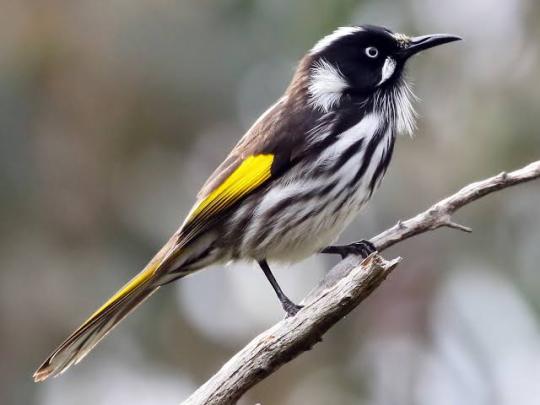
New Holland honeyeater (Phylidonyris novaehollandiae)
Small, social bird with dignified sideburns who subsists primarily off of sugar (with a side of insects and arachnids). Mobile, talkative, and known to gang up on larger birds, such as wattlebirds (below). Nimble fliers, but tend to navigate a flowering bush from the inside. Looks like an electric type pokémon.
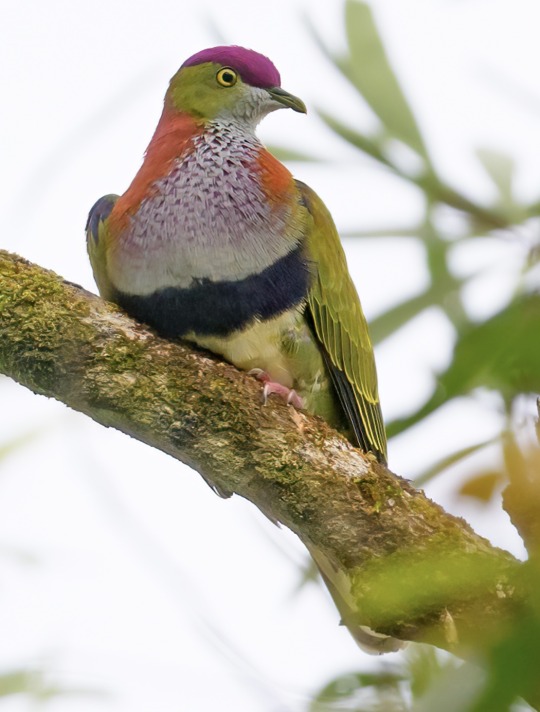
Superb fruit dove (Ptilinopus superbus)
Medium-small pigeon with an absolutely unrealistic colour palette (yet impressively camouflaged). Indeed superb. Also a dove that eats fruit. Not great at building nests. Migratory or nomadic but sneaky about it: possibly at night, as they (unfortunately) occasionally collide with lighthouses.
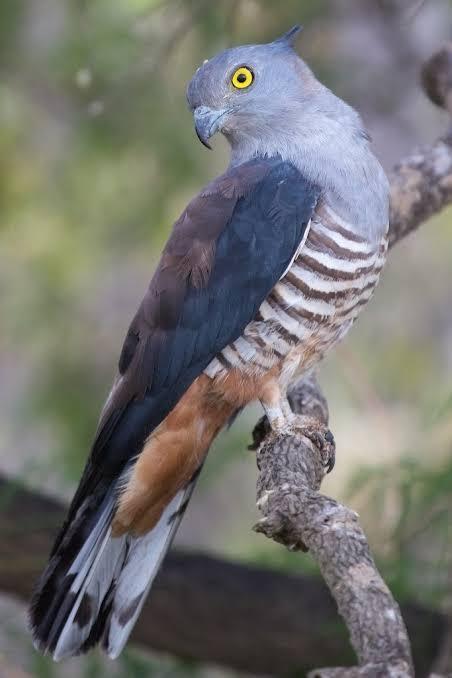
Pacific baza (Aviceda subcristata)
Looks as though a wizard has turned a cuckoo into a bird of prey in a futile attempt to teach it the meaning of hard work. In fact a medium sized, crested hawk. An omnivore: hunts everything from insects to reptiles to smaller birds, but also actively eats fruit. Rumoured to be able to mimic frog-calls, which coaxes the frogs to respond in turn. Pretty chill and, like many other hawks, social. Documented aerial somersaulter. Also not the greatest at nest building.

Red wattlebird (Anthochaera carunculata)
Not the prettiest, but interesting to watch. Large honeyeater and one of the few birds I am convinced has retained awareness of being a dinosaur. Loud about it, either with a gutteral cluck or lovely singing. Glides as much as flies, though they are perfectly capable of it. A decent climber, nimble. Will throw it's weight around with both smaller and larger birds. Unclear if it entirely understands it's place in the food chain.

Southern boobook (Ninox boobook)
A small, compact, cute and otherwise plain owl, but with very striking eyeliner. Does well in suburban areas. Named for the distinct noise it makes, though is (as most owls are) a totally silent flier. Feeds mostly on insects and small mammals but is also capable of catching bats.
62 notes
·
View notes
Photo
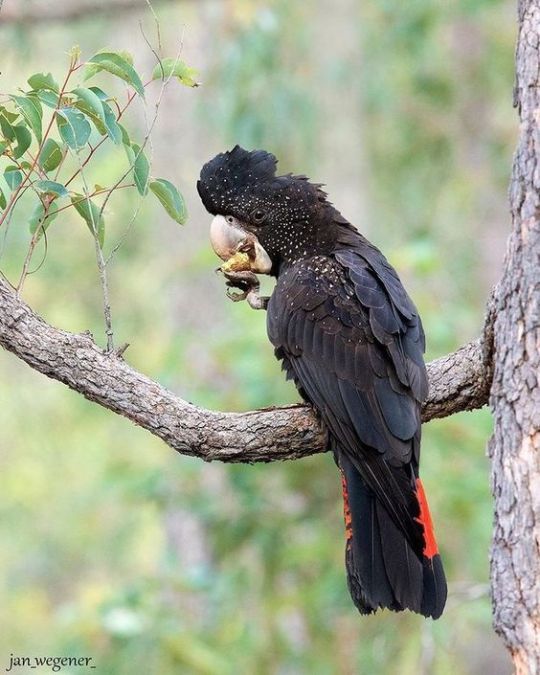
Forest Red-tailed Black Cockatoo (Calyptorhynchus banksii naso)
Known to the Noongar people as ‘Karrak’ this subspecies is only found in the humid and subhumid zones in the south-west and have a significantly longer and wider bill compared to the other two subspecies found in Western Australia.
📍 Perth, Western Australia
📸 @jan_wegener_
#jan wegener#bird photography#birds of australia#bird#wildlife#wildlife photography#karrak#forest red-tailed black cockatoo#cockatoo#noongar people#perth#western australia#australia
9 notes
·
View notes
Text

Red-tailed Black Cockatoo (Calyptorhynchus banksii), L - female, R - male, family Cacatuidae, order Psittaciformes, VIC, Australia
photograph by Adam Phillips (500px)
840 notes
·
View notes
Text
For #InternationalWomensDay + #WomensHistoryMonth: Marianne North is almost always labeled a botanical artist, but 121 of her Kew Gardens paintings also feature animals, like this one:
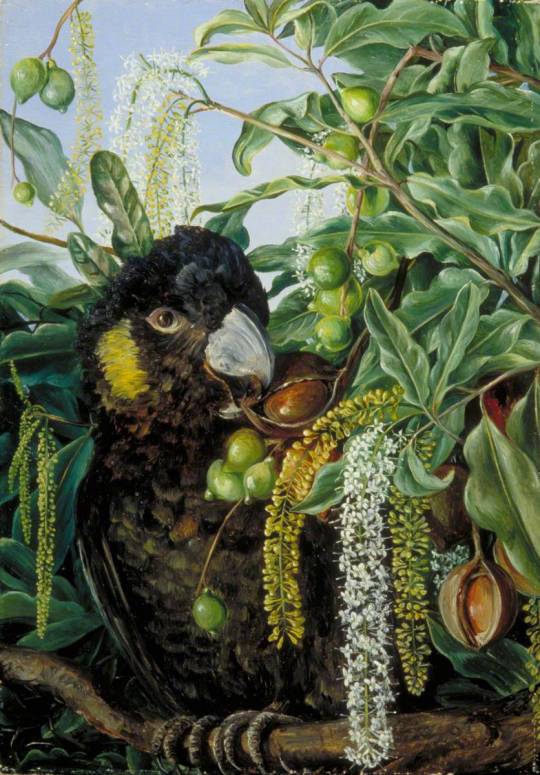
Marianne North (English, 1830-1890)
Foliage, Flowers and Fruit of a Queensland Tree, and Black Cockatoo c. 1880-1
painting, oil on board
H 50.9 x W 35.4 cm
Kew Gardens Marianne North Gallery [MN790]
PS - This bird is misidentified on the Kew Gardens website as a Red-tailed Black Cockatoo (Calyptorhynchus banksii), but it's actually a Yellow-tailed Black-Cockatoo (Zanda funerea) - the yellow cheek patch distinguishes it as the latter:
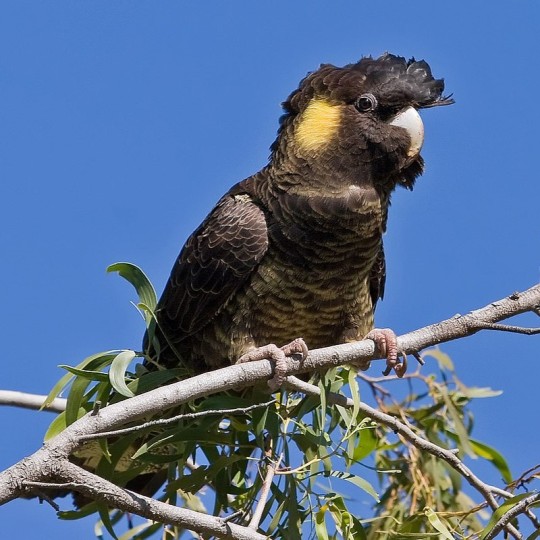
You can view all of Marianne North's paintings with animals in them here:
Bonus: Here's an actual Red-tailed Black Cockatoo (male) by Eileen Mayo, from her poster series made for the Australian National Travel Association in the 1950s. Fun wordplay here too - the bird's scientific name is Calyptorhynchus banksii and she placed it on a Banksia plant. :)

Eileen Mayo (1906-1994)
AUSTRALIA / COCKATOO & BANKSIA
c. 1955-7
poster, 39 3/4x25 inches, 101x63 1/2 cm.
Australian National Travel Association
#womenartists#hernaturalhistory#womeninscience#womeninhistsciart#Marianne North#Victorian art#English art#British art#bird#birds in art#parrot#cockatoo#Yellow-tailed Black Cockatoo#Macadamia#natural history art#scientific illustration#19th century art#European art#Australian art#Australian animals#Australian wildlife#painting#oil painting#Kew Gardens#Marianne North Gallery#International Womens Day#Womens History Month#Eileen Mayo#Banksia#Australian National Travel Association
10 notes
·
View notes
Note
Ok ok, top 5 birds you have heard but not seen, and! Top 5 bird calls?
I've only really had two birds that I've herd but not seen, as most birds don't tend to be so allusive as those two are (which I talked about in the previous bird ask), so I think I'll talk about the top 5 bird calls...and see if I can add some audio too 👀 if not then you'll never see this text lol
I should also mention that I picked bird sounds from birds that I've personally heard in my local area! Emperor penguin sounds are like the coolest bird sounds ever and they WOULD be my number one pick, but I don't live in Antarctica LMAO so Australian bird sounds it is!
It was also very hard to chose because i love birdies so much and all their calls can be incredible buttttt i managed it (just barely). also all the bird sounds came from xeno-canto which is an entire website dedicated to recording bird sounds from around the world and everyone should check it out <3 I've used the website many times to accurately identify mysterious birdies and not many people really talk about it as a resource for learning more about birds. also putting the rest of this answer behind a readmore cuz yeah..it got long again. LMAO
#5 Little Corellas
I love these silly little birds. they're very adorable, and when a whole flock flies over your head they can be VERY loud. They often hang out on the grass eating grass seeds and stuff. sometimes they jump and hop along on the ground too! funny birdies <3
#4 Pied Currawong
These guys have a variety of different sounds that they can make, but I chose the sound that I love the most <3 It's just such a nice sounds which itches the brain just right.
#3 Yellow-tailed Black Cockatoo
This is one of the birds that I've only heard, but not seen! I just love their calls, they're soo...idk...great sounding <3 It reminds me a bit of summer. I usually hear them in the distance, and only ever one or two since they're a bit rarer in my local area, but they're around at least!
#2 Australian Magpie
I don't think anyone is surprised by me adding this lol. Their calls are really unique, and over the years me and my mum have heard them make all sorts of cool noises, including mimicking the sounds of a horse! Because yes, they mimic as well as making their own unique sounds <3
#1 Torresian Crow
This might seem like an odd choice for number one....but I just really love crows! The reason I have it at number one is because of the trills they're capable of, which is showcased in the audio alongside their caws.
anyways...that's my fav bird calls! hope you liked em <3
5 notes
·
View notes
Text

A rescue red-tailed black-cockatoo female (Calyptorhynchus banksii) at the @raptordomain Kangaroo Island, South Australia.
#australia#south australia#kangarooisland#wildlife#wildlifephotography#bird#cockatoos#black cockatoo#canon#canonr5
1 note
·
View note
Text
The Great ACT-NSW-NZ Trip, 2023-2024 - The Rock
If you happen to be travelling from Sydney to Melbourne, one of the options is train, and one of the optional stops is The Rock, SW of Wagga Wagga. It used to be Hanging Rock (not the one from the movie) but in 1874 the eponymous hanging bit fell off the local mountain, so they redid the place sign. Funnily enough, another name for the town, Kingston, persisted on maps until at least 1916.



The local indigenous Wiradjuri nation call it Yerong and Kengal, and there are multiple very important cultural sites and creation stories associated with it.
Geologically The Rock is unique in the area - an outcrop of metamorphosed and uplifted Devonian age sediments, on the boundary of the Riverine Plain and the western slopes of the Eastern Highlands. The cliffs at the top are precipitous (and, until 1874, spectacularly overhanging in places) and the slopes are mostly screed and boulders broken off the rock further up. From the top you can see Australia's highest mountain to the SW, and if it wasn't for the curvature of the Earth, Africa to the west - it's the highest point left on the Australian continent, as you travel westward at that latitude.
Biologically it's pretty important too, becuase the overwhelming majority of the entire Riverina area has been cleared for farming. The
Rock Nature Reserve is large enough to still maintain a viable population of a number of bird species that have been lost from other smaller remnants. This includes Turquoise Parrot Neophema pulchella, Pink Robin Petroica rodinogaster and Glossy Black Cockatoo Calyptorhynchus lathami, and threatened mammals such as the Squirrel Glider Petaurus norfolcensis, and the Greater Long-eared Bat Nyctophilus timoriensis.
Eagles and Peregrine Falcons nest on the cliffs, so rock-climbing is banned in nesting season. Almost 100 other bird species have been recorded on the reserve.
Of course it's not the first time I've been to The Rock, and there's a fair few species I saw on this trip that I've covered before- here's some pics, reblogs to follow, then the newer stuff.









#the rock#hanging rock#australian riverina#australian spider#introduced species#australian ant#australian grasshopper#australian fly#australian monotreme#monotreme#echidna
0 notes
